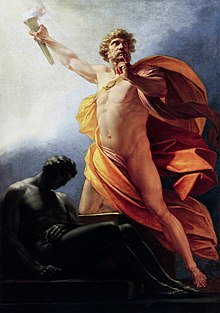文化英雄--用語集(3)
文化英雄
文化英雄(ぶんかえいゆう、culture hero)とは、火や作物の栽培法などの有意義な発明や発見をもたらし、人間世界の文化に寄与したとされる伝説的人物やある種の動物のことをいう。
文化英雄は民族、部族の始祖やトーテムとして位置づけられることも多い。また文化英雄は至高神や創造神と異なり、既存の世界の上で特定の文化要素の創造を行う存在である。文化英雄の中には、いたずらを行う異界の存在であるトリックスターである例も見られる。
例えば、ポリネシア神話のマウイは、 無数の冒険譚の主役であり、火を人々にもたらし、主要な技術の発明をもたらした存在であるとともに、いたずらや反社会的行動をするトリックスターでもあ る。彼は異常出生した半神半人の出自を持ち、次々と天・地上・地下界に滞在し、その活動が神々と人間の間を絶えず往復しながら展開する。このことは、彼に 両義的性格をもたらし、トリックスターの地位を与えるとともに、人々に欠けていたものを異界、外部からもたらすという文化英雄の役割を可能にさせている。
アメリカ・インディアンの神話では、しばしばコヨーテなど特定の動物が文化英雄とトリックスターの両面を持ち、秩序と破壊、文化と自然の媒介者の位置を占める。
主な文化英雄
- プロメーテウス
- 神話に登場する文化英雄としてよく知られているのは、ギリシア神話のプロメーテウスである。彼は、ゼウスの意志に逆らい、火や穀物を人間にもたらす。その行いに怒ったゼウスは、彼をカウカーソス山の山頂に張り付けにし、生きながらにして毎日肝臓をハゲタカについばまれる責め苦を与えた。
- ケツァルコアトル
- 中米で大きな勢力を誇る翼蛇神ケツァルコアトルも、著名な文化英雄である。彼はアステカ神話における主要な神であり、人類を創造した神であり、火をもたらし作物を与え、農耕、文化、芸能など人類に必要なあらゆるものを伝えたとされている。
(創造主はこれを知り、二人をエデンから追放した。いわゆる「原罪」である。)
List of culture heroes
A culture hero is a mythological hero specific to some group (cultural, ethnic, religious, etc.) who changes the world through invention or discovery. A typical culture hero might be credited as the discoverer of fire, or agriculture, songs, tradition, law or religion, and is usually the most important legendary figure of a people, sometimes as the founder of its ruling dynasty.
Abenaki mythology
- Bedig-wajo (western)
- Ktaden (eastern)
- Glooscap
Australian Aboriginal mythology
Abrahamic religion (Judaism, Christianity, Islam)
Armenian mythology
Ashanti mythology
Aztec mythology
Banks Islands mythology
Caroline Islands mythology
Celtic mythology (Irish, Welsh)
- King Arthur
- Cúchulainn (Irish)
- Diarmuid Ua Duibhne (Irish)
- Lug (Irish) or Lleu Llaw Gyffes (Welsh)
- Fionn mac Cumhail (Finn McCool) (Irish)
- Oisín (Irish)
- Pwyll (Welsh)
- Bendigeidfran (Welsh)
- Pryderi (Welsh)
- Gwydion (Welsh)
Chinese mythology
- Nuwa
- Chi-You
- Shennong
- Fu Xi
- Suiren
- Leizu
- Cangjie
- Yellow Emperor
- Yao
- Shun
- Guan Yu
- Laozi
- Mazu
- Shujun
- Bodhidharma
- Zhang Sanfeng
- Yu the Great
- Ji Fa
Egyptian mythology
·King Thutmose III (the third)
English mythology
Etruscan mythology
Finnish mythology
Greek mythology
- Achilles
- Bellerophon
- Cadmus
- Cecrops
- Castor and Pollux
- Hektor
- Diomedes
- Herakles
- Odysseus
- Palamedes
- Perseus
- Phoroneus
- Prometheus
- Theseus
- Triptolemos
Hungarian mythology
Inca mythology
Indian mythology
- Krishna
- Rama
- Vikramaditya
- Harishchandra
- Shivi
- Karna
- Arjuna
- Bhima
- Rishabha
- Yudhishthira
- Mamuni Mayan
- Bhishma
- Duryodhana
- Ravan
- Shakuni
- Bharat
- Draupadi
- Sita
- Parashurama
- Vishvamitra
- Lakshmi
- Hanuman
Ho-Chunk mythology
Inuit mythology
Japanese mythology
Lakota mythology
Maya mythology
Mesopotamian mythology
Norse mythology
Ohlone mythology
Ojibwe mythology
Persian mythology
Polynesian mythology
Roman mythology
Scottish mythology
Serbian mythology
Slavic mythology
Solomon Islands mythology
Folklore of the United States
- Pilgrims
- Davy Crockett
- Daniel Boone
- Lewis Wetzel
- Francis Marion
- Kit Carson
- Paul Bunyan
- Johnny Appleseed
- John Henry
- Tom Sawyer and Huckleberry Finn
Ute mythology
Vietnamese mythology
Weenhayek mythology
Zuni mythology
References
Žikić, Bojan (1997). Културни херој као "морални трикстер": Свети Сава у усменом предању Срба из БиХ [Culture hero as "moral trickster": Saint Sava in oral traditions of Serbs in BiH] (PDF). Bulletin of the Ethnographical Institute SASA (in Serbian). Belgrade. XLVI: 122–128. Retrieved 2010-07-05.
Bunjil
In Australian Aboriginal mythology, Bunjil the eagle (or eaglehawk) is a creator deity, culture hero and ancestral being. In the Kulin nation in central Victoria he was regarded as one of two moiety ancestors, the other being the trickster Crow. Bunjil has two wives and a son, Binbeal the rainbow. His brother is Balayang the bat. He is assisted by six wirmums or shamans who represent the clans of the Eaglehawk moiety: Djurt-djurt the nankeen kestrel, Thara the quail hawk, Yukope the parakeet, Dantum the parrot, Tadjeri the brushtail possum and Turnong the gliding possum.
According to one legend, after creating the mountains, rivers, flora, fauna, and laws for humans to live by, Bunjil gathered his wives and sons then asked Crow, who had charge of the winds, to open his bags and let out some wind. Crow opened a bag in which he kept his whirlwinds, creating a cyclone which uprooted trees. Bunjil asked for a stronger wind. Crow complied, and Bunjil and his people were blown upwards into the sky. Bunjil himself became the star Altair and his two wives, the black swans, became stars on either side.[1]
A Bunurong story tells of a time of conflict among the Kulin nations, when people argued and fought with one another, neglecting their families and the land. The mounting chaos and disunity angered the sea, which began to rise until it had covered the plains and threatened to flood the entire country. The people went to Bunjil and asked him to help them stop the sea from rising; Bunjil agreed to do so, but only if the people would change their ways and respect the laws and each other. He then walked out to the sea, raised his spear and ordered the water to stop rising.[2]
It is believed by the Kulin and other Indigenous peoples that, in the Dreamtime, Bunjil took shelter in a cave located in the part of Gariwerd that is now known as the Black Range Scenic Reserve. Bunjil's Shelter is today a popular tourist attraction and one of the most important Aboriginal rock art sites in the region.[3][4]
References
- Mudrooroo (1994). Aboriginal mythology: An A-Z spanning the history of the Australian Aboriginal people from the earliest legends to the present day. London: Thorsons. pp. 23–24. ISBN 978-1-85538-306-7.
- Carolyn Briggs (2000-05-31). "Boon Wurrung Story". Yarra Healing. Retrieved 2011-02-15.
- Richard Everist (2009). Traveller's Guide to the Goldfields: history and natural heritage trails through Central and Western Victoria. Australia: Best Shot. p. 95. ISBN 978-0-9756023-3-1.
Parks Victoria (2009). "'Bunjil Shelter' - Black Range Scenic Reserve, Stawell - Visitor Guide" (PDF). Park Notes. Retrieved 2013-03-30.



